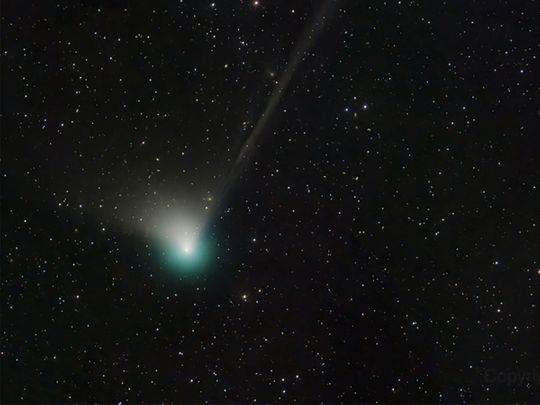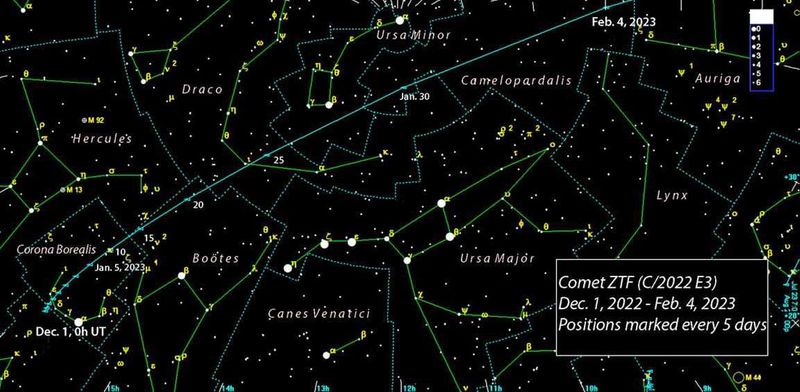
A rare green comet has appeared in the night sky for the first time in 50,000 years. Skywatchers can catch a glimpse of this cosmic wanderer as it nears Earth in a once-in-a-lifetime occurrence.
The Comet C/2022 E3 (ZTF) was spotted from the Abu Dhabi desert at dawn on January 14, according to the International Astronomy Centre (IAC) based in the UAE capital.
The comet, first identified in March 2022, hasn’t visited Earth or the inner solar system since the last Ice Age. The last time the comet passed Earth was during the Upper Paleolithic period, when Neanderthals walked the Earth, according to Space.com.
C/2022 E3 (ZTF reached its closest point to the Sun (perihelion) on January 12 and will be visible for nearly a month, according to NASA. The icy visitor from the distant outer solar system will be at its brightest on February 2 when it is closest to Earth, visible in the constellation Camelopardalis.
The comet orbits the Sun and passes through the outer reaches of the solar system, which is why it took so long to swing by Earth again, according to The Planetary Society. The comet’s next visit to the inner Solar System is expected in another 50,000 years.
What’s a comet?
Comets are believed “to have originated early in the Solar System history,” Roger Clark, a senior scientist at the Planetary Science Institute in Arizona, US, told Forbes. The frozen leftovers from the formation of the Solar System are composed of frozen gases, dust and rock. Comets don’t emit their own light, but as they orbit closer to the Sun, they heat up and spew gases and dust into a glowing head. This material forms a tail that stretches millions of miles.
There are likely billions of comets orbiting our Sun in the Kuiper Belt (a flat ring of small icy bodies that revolve around the Sun beyond the orbit of Neptune) and even more distant Oort Cloud (a predicted collection of icy objects farther away than everything else in the Solar System).
When was C/2022 E3 (ZTF) discovered?
Comet C/2022 E3 (ZTF) was discovered by Frank Masci and Bryce Bolin on March 2, 2022, using the Zwicky Transient Facility’s wide-field survey camera at the Palomar Observatory in San Diego County, California. It was initially believed to be an asteroid, but its rapid brightening during the move from the inner orbit of Jupiter indicated a true cometary nature. At the time of its discovery, the comet was within the orbit of Jupiter, nearly 643 million km from the Sun.
Why is the comet named C/2022 E3 (ZTF)?
It was the third space object found by astronomers in the fifth half-month of the year. Half-months are used in astronomy to separate months into two sections: day one through day 15, and day 16 through the rest of the month. Each half month is associated with a letter.
For example, from January 1 to 15, it is A; from January 16 to 31 is B; from February 1 to 15, it is C and so on. When objects such as asteroids and comets are discovered, they’re given an alphabetical label to distinguish when they were found. So, March 2 falls into E, thus explaining 2022 E3. Since it was discovered at the Zwicky Transient Facility, it gets the ZTF suffix, according to EarthSky.

When will it come near the Earth?
The comet came to around 160 million km from the Sun — the closest point called perihelion on January 12. It will move northwest on the horizon throughout January and makes the closest pass of Earth — called the perigee — between February 1 and 2, according to NASA. During that time, the comet will be around 42 million km away from the planet, according to astronomers.
How can you see the comet?
The comet should be visible through binoculars in the morning sky in the Northern Hemisphere during January and in the Southern Hemisphere in early February, according to NASA. From January 12, the comet will be seen near the northern sky constellation Corona Borealis before it moves westward, according to Space.com.
By the third week of January, as C/2022 E3 nears Earth, observers will be able to spot it near the bright star Polaris, also called the North Star, and it should be visible earlier in the evening. Its visibility will depend on the weather, including interference from the Moon or clouds.
By February 1, it will be near the constellation Camelopardalis, and on February 5 and 6, the comet will pass to the west of the star Capella and then enter the constellation Auriga.
Stargazers can watch it on YouTube or the live stream provided by the Virtual Telescope Project.
Can you see the comet with the naked eye?
Experts expect C/2022 E3 (ZTF) to be visible to the naked eye by the third week of January, depending on how bright it becomes in the coming weeks. “Comets are notoriously unpredictable, but if this one continues its current trend in brightness, it’ll be easy to spot with binoculars, and it’s just possible it could become visible to the unaided eye under dark skies,” NASA wrote on its “What’s Up” blog.
Where can you see it in the UAE?
The Abu Dhabi-based International Astronomy Centre viewed the Comet C/2022 E3 from the Al Khatim Observatory on Saturday (January 14) morning and shared a video. "A video of the movement of comet C2022 E3 (ZTF) from the UAE sky at dawn today, Saturday, January 14, 2023 CE, from 05:01 to 05:36 UAE time,” it tweeted.
The IAC reported that the comet was spotted from the Abu Dhabi desert at dawn, shining at magnitude 6.5 with a dust tail and an ionic tail that was seen opposite the sun at 307 degrees.
The Dubai Astronomy Group is organising a C/2022 E3 comet observation and stargazing event from 6.30pm to 9.30pm on February 4 at Al Qudra Desert, according to their website.
What does the comet look like?
The comet C/2022 E3 can be differentiated from stars by its streaking tail of dust and energised particles and the glowing green coma around it. The coma is an envelope that forms around a comet as it passes close to the Sun, causing its ice to turn directly into gas, making the comet look fuzzy.
How big is C/2022 E3?
Made of ice and dust and emitting a greenish aura, the comet is estimated to have a diameter of around a kilometre, said Nicolas Biver, an astrophysicist at the Paris Observatory. That makes it significantly smaller than NEOWISE, the last comet visible with an unaided eye, which passed Earth in March 2020, and Hale-Bopp, which swept by in 1997.
Where did this comet come from?
The comet was believed to have come from the Oort Cloud, a theorised vast sphere surrounding the Solar System that is home to mysterious icy objects.
What was the last visible comet?
Comet C/2020 F3 NEOWISE — or NEOWISE for short, was discovered on March 27, 2020. It gets its name from the NASA mission that found it, also called NEOWISE, for Near-Earth Object Wide-field Infrared Survey Explorer, a mission that keeps track of asteroids near Earth — especially the ones that could be hazardous to our planet. NEOWISE takes nearly 7,000 years to complete a loop around the Sun, so it’s truly a once-in-a-lifetime event.
What do we learn from comets?
Since comets arrive from the outermost parts of the Solar System, which are frozen, they will be made up of material from this region, like dust, water, and carbon dioxide ice. When C/2022 E3 nears the Earth and Sun, scientists will examine these components and learn about the evolution of the Solar System from 50,000 years ago, when the comet last arrived. It will give us information about our Solar System well beyond the most distant planets.











